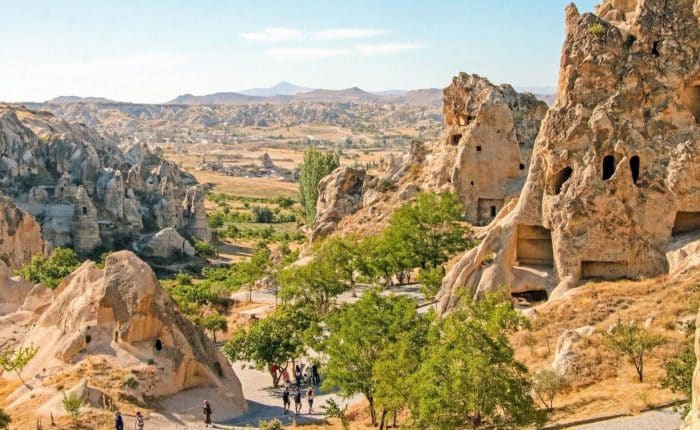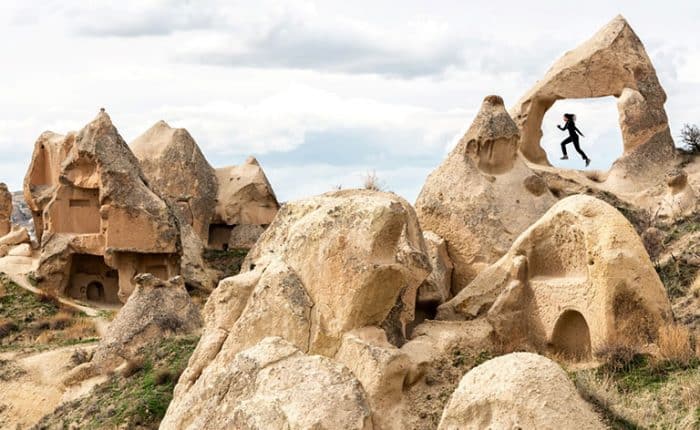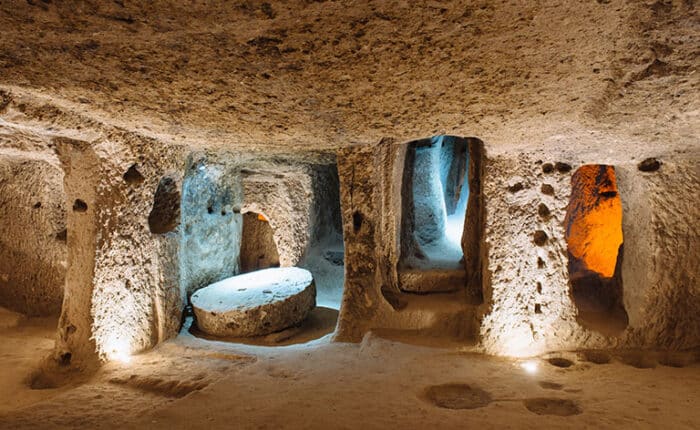In many ways, the histories of Kapadokya and Turkey are intertwined. Yet, the distance between Cappadocia and Istanbul (for many centuries Turkey’s capital city) was significant enough for some autonomy for the outlying region.
The earliest remains of a human being date back to 8000 BC, carbon-dated out of three pottery pieces of hunter-gatherers found in a cave called Civelek.
Pottery and tools from the Neolithic era have been discovered in Cappadocia, indicating an early human presence there. Archaeological digs near the modern town of Kultepe have uncovered the remains of ancient Kanesh, a Hittite-Assyrian city.
It is known that the ancient region served as a crossroads for numerous travelers and merchants in the Ancient World. Seljuk Turks, ancestors to many modern Turks, first lived in Central Asia around 2000 BCE.
They controlled many autonomous states and empires throughout vast areas of Asia as well as in Europe. This lasted until the Persian invasion in the 6th century BCE. Many Seljuk Turks eventually would settle in the area.
By the fourth century, Christians fleeing Rome’s persecution had arrived in Anatolia in large numbers and established monastic communities there. This explains why churches and monasteries account for so many historical structures in modern-day Cappadocia.
The marvelous city of Constantinople was founded by Emperor Constantine the Great in 333 as the “New Rome.” After the fall of the original Rome in 410, Constantinople took the place of the older imperial capital altogether.
When completed in 537, the magnificent Hagia Sophia church (still a very prominent Istanbul landmark) was hailed as the most significant church in the Christian world. It has maintained that accolade for nearly a thousand years.
In the 11th century, the Seljuk Turks mentioned above began to arrive in Anatolia. Following a victory over the Byzantines, they established the Anatolian Seljuk State, which lasted from 1080 to 1308.
European Crusade armies marched through Anatolia during the 12th and 13th centuries, fighting the Seljuks and threatening Constantinople. Meanwhile, the Ottomans were starting to gain traction throughout the area around 1300.
The region of Cappadocia has withstood not only the test of time but also multiple transitions in the dominant peoples and culture. It’s located in Turkey’s Goreme Valley in the Province of Nevsehir.
This region is part of Central Anatolia, on the plateau north of the Taurus Mountains. The region is about 300 km² (roughly 186 miles²) and spans the area with the cities of Kayseri in the east and Karapinar in the south-west.
Within the region, Goreme is the town that’s best known for its fairytale-like stone structures, though they exist elsewhere too. Goreme is home to about 2,000 people and has served as a cultural crossroads for millennia.
Other popular towns and cities in the region include Uchisar, Cavusin, Avanos, Ortahisar, Urgup, Ihlara, Mustafapasa, Kaymakli Derinkuyu (underground cities). Each of these towns and cities has its unique attractions. Read more about them and decide which ones you might want to visit someday.
The ash from now-dormant volcanoes formed Cappadocia’s remarkable landscape. Over time, the ash hardened into the soft stone. It was carved over eons by a combination of natural erosion from rivers and streams—along with a fair amount of human ingenuity.
Known as “hoodoo landforms,” the Cappadocia caves (“fairy chimneys”) are tall, slender, cone-shaped spires of rock protruding from the base of an arid drainage basin. The region has an abundance of these.
Over many centuries, Cappadocia’s hoodoos have been carved into structures ranging from churches and monasteries to contemporary shops and homes.
Labyrinths of underground tunnels augment the carved-stone pinnacles that you see on the horizon, making subterranean cities that are mostly invisible to those who aren’t aware of them.
Between the Middle Cretaceous and Cenozoic Era (from 100 million to 60 million years ago), the collision of the Afro-Arabian plate and the Eurasian triggered the geological process covering an area of 10,000 square kilometers. While we can hardly see the craters of those volcanoes that formed today’s Cappadocia, it was like a “dolce vita” creating a different layer of thick ash every one million years.
A Roman historian named Strabo imagines it was more like a big forest that a monkey could swing through the trees for more than three kilometers without touching the ground. Following Strabo’s imagination, we can think that the area was surrounded by an inner sea and little hills before the volcanoes became active- roughly around the middle Miocene (15 million years ago).
Eventually, with all the volcanic eruptions, it started to get covered by thick ashes and various rock units of ignimbrite and tuff. Rest was taken care of by the strong wind, snow, and rain giving its current surreal and characteristic rock formations turning everything into soft rock, changing it entirely. However, the Red River remains the only original natural feature, still running through the region as Turkey’s longest river.
Millions of years of work paid off, and the whole area turned into desert-looking geography, and that makes it a haven for geologists.
The source of the name “Cappadocia” is somewhat uncertain. It comes up twice in the King James Bible; thus, the region might have been given the name during ancient times.
For a long time in the late 20th and early 21st centuries, Kapadokya was said to mean “the land of beautiful horses” (translated from the Persian). It was revealed recently, though, to be something Turkish tour guides were instructed to tell tourists in the 1980s.
Photographer and researcher Ozan Sagdic revealed only a few years ago that Cappadocia doesn’t mean “the land of beautiful horses.” Instead, it was a story he had to tell to avoid the wrath of the 1980 coup administration in Turkey.
The myth lives on in the minds of many people, though.
Like its name, Cappadocia’s history — even that of Turkey as a whole — has many twists and turns. History is never easy, nor is it entirely verifiable. The following section captures the essence of the histories of both Kapadokya and Turkey.
A trip to Cappadocia is well worth the time. You might want to set aside a week—to include travel, plus a good three to four days to take in the region.
Turkish summers can be hot, and, specifically in Cappadocia, winters can be cold and snowy. Generally, the weather in Central Anatolia during early-to-mid fall and late spring is pleasant, though. These are good times to visit.
There are several ways to get to Cappadocia, especially if you’re arriving from Istanbul—where most international travelers begin their journeys to the country’s Anatolian center.
Two small airports lie within a reasonable drive, both well under two hours from the heart of Cappadocia. They are in opposite directions from the town.
Kayseri’s Erkilet International Airport, a small-sized facility that doubles as a military base, is the closest airport to Urgup, which is about an hour’s drive away. There are no direct flights from the U.S., but Turkish Airlines connections from Istanbul are pretty straightforward.
Connections are also available through Amsterdam, Rotterdam, and several German cities (effective 2020). Other flights are available seasonally.
As tourists call it, the Cappadocia Airport is located to the north of Nevsehir. This airport has fewer flights than half the arrivals and departures daily than at Kayseri Airport and is served only by Turkish Airlines for the moment.
However, the proximity to Uchisar alone could make it worth your while to use this airport instead of more distant Kayseri. Plus, it’s easier to get a shuttle service from Nevsehir Airport to Uchisar, Avanos, or Goreme.
Many people enjoy long train rides for the view of the countryside. If you’re one of them, you might consider traveling from Istanbul by train. While central Cappadocia doesn’t have a train station, other cities in Central Anatolia do. The closest station you can get to is Kayseri, and then you need to get a private transfer service for one hour ride to get to your hotel.
Since Turkey’s railway system isn’t all that widespread at this point, none of the cities with train stations are especially close to Cappadocia, but all have bus service to the region. Ankara probably would be a better choice to travel by train from Istanbul. After touring this capital, you can head to Cappadocia, also visiting Lake Salt on the way near Aksaray.
It’s also possible to travel from Istanbul by bus, which takes 10-12 hours. Turkish buses are relatively clean and comfortable—which is good since you might want to nap during the journey. However, no matter how comfy they are, bus trips are generally exhausting, and once you arrive at your destination, you will feel a lot more tired as if you drove all night.
Renting a car in Turkey is relatively easy, especially if you don’t mind traffic in the larger cities and have a GPS to guide you. There are car rentals throughout the region, including at both airports.
It can be convenient to have access to a car while seeing the area since not all that’s worth seeing is located in one place.
Traveling on your own is fun to enjoy lifelong memories with the beloved one or your family. Still, since this is a lot of history to understand what you are seeing and add meaning to this Mother Earth’s creativity, we do highly recommend to enjoy a guided tour, at least for one way.
Of course, a fantastic travel option is a guided tour—which can save the need to make travel arrangements or find your way around the area and its many attractions. You’ll also benefit from all the insider knowledge and history of the surrounding cities and towns by one of our expert guides.
Depending on where you are in the region and what you want to see, you have some transportation options to consider. However, public transportation still might be challenging for you as it is either limited to every 30 minutes / 1 hour and stop running after a proper time in the evening. Living here for a long time now, to get to historical sites, underground cities, or dining out, we do always get a private car as well.
Cappadocia, like most other destinations in Turkey, enjoys four seasons and it is completely different and beautiful at each of those seasons. In winter, snow covers the beautiful landscape like a bridal gown, while in spring and summer, you have a beautiful sun with clear weather and mostly breezing nicely.
During the tourist season, truly memorable lodging in the Cappadocia region ranges from 90 EUR to 1200 EUR per night, with accommodations for a lower-priced. However, you can still get a standard room starting at 60 EUR if your preferred accommodation is four-star or a small pension.
Hotel options range from international chains like Hilton to locally owned and operated hotels built into the caves. There’s something to appeal to about any taste within the region, including rooms with a private pool inside.
Keeping an up-to-date hotel list; we know our way around and inspect most hotel rooms to list our favorites as we get to know your taste by asking some more specific questions. By doing so, we do finally book you the best match, saving your time and cash before you find yourself getting lost in booking engines.
Many hotels have the classical and international amenities with free Wi-Fi (yes, inside most caves), but be sure to check in advance if the place you want to stay has the amenities you consider essential.



The top-rated attractions are ancient caves, churches with dazzling wall paintings, labyrinthine underground cities, and castles carved out of the hillsides as a shelter both to cope with the harsh weather conditions and invaders. It’s an enchanting destination filled up with places to visit both for nature-lovers and history buffs can relish.
So, go ahead and start making your “must-see” list.
The natural wonder of Cappadocia is the main reason people travel to the region. Unlike many of the world’s natural sites, the region has both natural rock formations and those that have been carved out so that people can live inside them since the early centuries.
In other words, Cappadocia provides the opportunity to see what happened eons ago, hundreds of years ago, or during the past century—all in one place.
If you’re interested in any of our tours, please let us know. We want to be your guides when you travel to our beautiful country.
On some days of the week, direct flights are available from Kayseri Airport to Izmir for Ephesus and Antalya. If you like scenic rides, you can also enjoy visiting Konya, which is home to some of Seljuks’ most significant landmarks (e.g., the Shrine of Rumi and the neolithic site of Catalhoyuk).